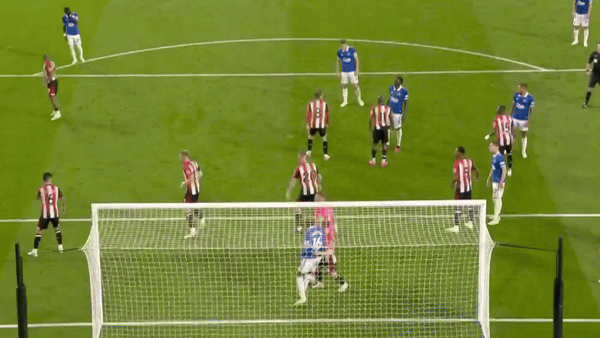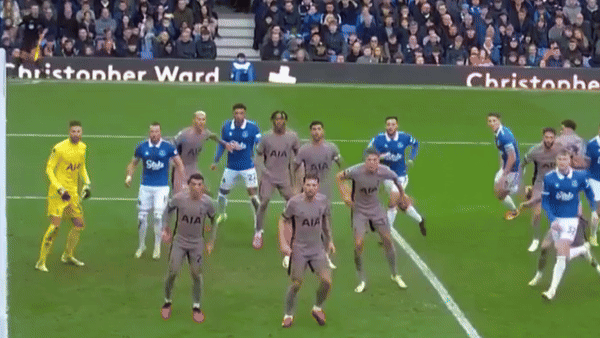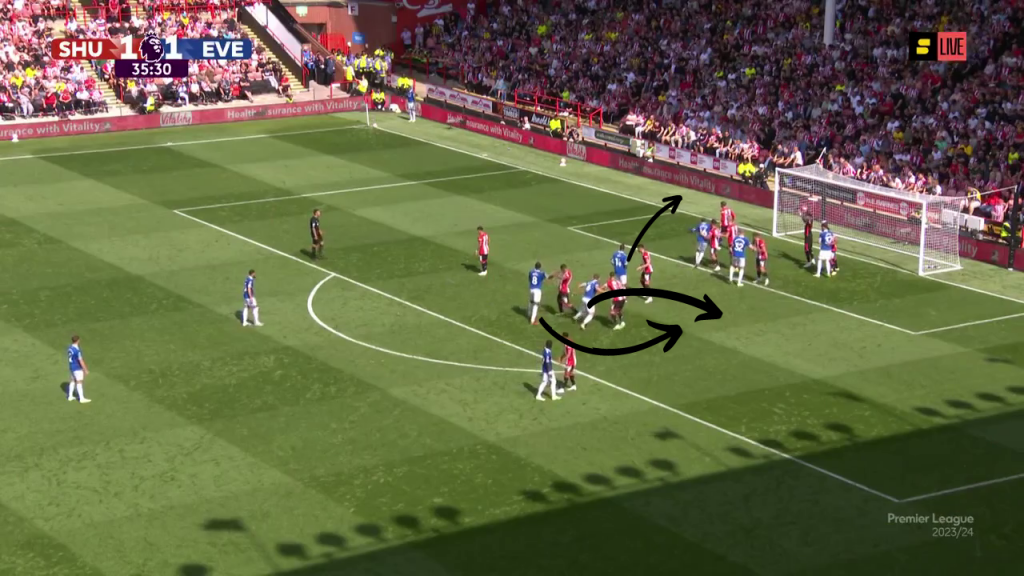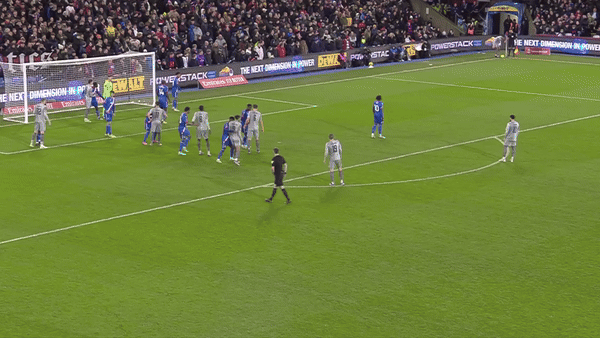Mohamed Mohamed looks at how an Everton team struggling to create in open play have cleverly used set pieces to fashion chances effectively instead
The 2023-24 season has been a trying time for Everton, and their six point deduction for financial issues has them currently near the relegation zone. The cumulative effect is that it’s left them with a squad that has a relatively low ceiling on what it could accomplish in open play. As a result, Everton have had to look to other avenues to score goals and if there’s been one area that’s been very effective for them, it’s been set pieces.
The positive effect set pieces can have across the table might still be under-appreciated despite the progress seen in the area. Liverpool and Manchester City have consistently been among the top of the leaderboard in set piece goals over the years, which has played a notable part in their numerous title challenges. Arsenal have expertly used them to alter the game state in their favor and control matches this season, which has powered their own title hopes. The likes of Newcastle and Brentford were so prolific last season that they overperformed their final table position relative to their wage bill. Although more clubs are recognizing how much of an equalizer set pieces can be across a 38 game season, as shown by Chelsea splashing the cash to recruit Brentford’s set piece expert, there’s still some meat on the bone.
Everton are an example of set pieces helping keep a club above water, as it’s been a lifeline for them while dealing with the points deduction. According to Opta’s The Analyst, no Premier League club has generated more shots and expected goals during dead ball situations. The gap between themselves and 2nd place Brentford in set piece expected goals is nearly akin to 2nd and Manchester United in 12th. Only Arsenal have scored more goals from set pieces. An argument can be made that Everton has been the best PL club in terms of set pieces this season. These stats are even more impressive when you consider how much it’s covered up Everton’s inability to score from open play, as they’ve had the largest negative difference between open play expected goals and actual goals.
It’s undoubtedly true that the personnel Everton have makes set pieces a more viable path towards consistently generating quality chances. Having the likes of Amadou Onana and James Tarkowski certainly helps in this department. However, simply having a bunch of tall and strong players doesn’t mean it’s a guarantee to be great during this phase of play. Rather, being well drilled in creating controlled chaos is essential for dead ball routines. This post will be detailing some of the ways they’ve been successful with their corners.
Use of Screens
Screens or blocks are a common way to create confusion during corners and indirect free kicks, especially against heavy man-marking defenses. They’re used to free up runners to attack space and that can lead the opposing team’s defense to bend. The most successful clubs in these situations tend to use screens in some form. When combined with decoy runs, it’s a very effective tool to generate quality chances. The use of screens is something you’ll see all the time in basketball, and its greater utility helped revolutionize the sport over the past 20 years.
Given that Everton have been among the league leaders in set piece play, it’ll be no surprise to hear that they’re quite effective in the art of screening. The back post routines they heavily rely on necessitate creating space for others to take advantage of, whether it be a single runner or a couple. Abdoulaye Doucouré is a key factor in Everton’s screen usage around the six-yard-box. Constantly, you’ll see him back himself into the opponent and take them out of the sequence so one of his teammates can have a clearer lane for a header near the centre of the goal. Their second goal versus Brentford shows how important his screens can be. He initially takes out both his marker and Brentford’s GK Mark Flekken, which means Tarkowski just has to muscle through Mathias Jensen for a clear attempt at goal. James Garner also plays a role by holding Ethan Pinnock for just long enough that he can’t provide help to Jensen once he loses his battle.

Some clubs will try and take it one step further by not only screening the outfield players, but the goalkeeper as well. Arsenal have experimented with this tactic this season. Dyche himself has done this back during his time with Burnley when they were prolific in set pieces, and it’s been the case while managing Everton. The idea behind screening the goalkeeper is pretty simple; to make it tougher for them to come out and control the six-yard-area. More often than not, keepers will look to be proactive in these moments and so the screens try to dissuade them from doing so.
It’s common to see Everton set up their corners where one of the players is directly in front of the GK. Against Tottenham, Jack Harrison was tasked with constantly bumping and chipping Guglielmo Vicario to get him off balance, and it largely worked in Everton’s favor. In the example below, Vicario has to scurry quickly backwards after losing the battle with Harrison and is forced into a desperation save.

One counter to this is by having someone mark the screener to make him less of a factor. In the sequence below, Marcus Rashford is trying to man-mark Dominic Calvert-Lewin so Andre Onana isn’t occupied. To counteract the adjustment, Everton places a second player in the goalkeeper’s airspace. Andre Gomes comes in and takes over screening duties, which momentarily has Onana stuck at the six-yard line. Although Manchester United ended up clearing the danger, there was a brief panic before Tarkowski won the first ball because of Gomes’ screen.

Effective Runs
In conjunction with screens/blocks, having purposeful movement is key to threatening corner routines. Misdirections can add further strain to defenders, who then have to make split-second decisions on which angles to take. This is especially tough when having to navigate around screens. As well, different alignments before the kick is taken have different pressure points that they want to exploit.This includes the stack formation where multiple players stand in a straight line, or a pack with everyone bunched up together. Both can lead to miscommunication on how to handle potential switches and eventual mismatches.
When it comes to Everton, they generally like to have a few players around the penalty spot when man-marked by the opposition. Although it’s usually more of a pack formation, they’ve dabbled with utilizing the stack on occasion. Within the stack alignment, the player furthest back would look to make a run from deep to the far side. Both the stack and pack alignments have runs being made in different directions but the emphasis tends to be on overloading the far post and creating matchup advantages.

An interesting wrinkle Everton will occasionally use with their corners is having everyone situated close to the far post, with a couple of players making runs to the zone which are aided with screens. This is somewhat similar to what Brentford have done with their setup over the past two years. A big difference between the two is Brentford’s players will end up dispersing to different areas while Everton overload a particular spot.

This corner versus Newcastle is illuminating because although it was called for a foul, it is the quintessential routine from Everton, as it combined an attempted screen on the GK along with some far-post action. Miguel Almiron is initially tasked with defending Calvert-Lewin, but doesn’t put much initial resistance on him which forces Lewis Miley to try and clean things up. All the while, Tarkowski uses an off-ball feint to get a step on Joelinton towards the far post himself.

Personnel
While it was mentioned earlier that personnel alone doesn’t guarantee success in set pieces, it is undoubtedly true that the level of physicality across Everton’s squad is a factor. Multiple players are above 6’0 in height, including Calvert-Lewin, Onana, and Tarkowski. Others like Doucoure, Garner, and Mykolenko are pushing 6’0 themselves. Numerous Everton players possess above average strength and/or leaping ability, which adds to the difficulties in containing them during corners. Add to it that McNeil is one of the best corner kick takers in the league in terms of consistency with the in-swingers towards the far post, and you end up with a very good base to work with.
Onana’s vertical prowess pops out whenever he’s involved around the back post. The ability to outleap people combined with his height at nearly 6’2 makes him very difficult to deal with during set pieces. According to Understat, only Calvert-Lewin, Tarkowski, and Doucoure have had more shots from corners among Everton players this season. Even when tightly marked, it feels that Onana more times than not can emerge from the crowd.
This sequence vs Crystal Palace shows how much of a weapon Onana can be during corners. He takes a quick look and notices that Tarkowski is ready to head it across the six yard box, so he fades to the far post to position himself to have an advantage for the second ball. His leaping ability comes into the fold and leads to a decent chance.

In comparison, Tarkowski uses more of the dark arts to create separation for himself. You’ll see him often attempt sneaky jersey grabs or shoves to the back while backpedaling towards the far post. This is especially tough to defend for the opponent marking him when they also have to account for navigating the screens they’ll be put through around the six yard box. He’ll also use a swim move to try and get inside leverage. All of this makes Tarkowski very helpful as a target for the first ball, just like in the example above.
Set pieces and particularly corners have been essential to Everton’s current game model under Sean Dyche. They’ve taken advantage of their squad profile to engineer effective choreographed movements during corners, which has led to the club having the highest expected goal output from them and ranking tied for 2nd in goals, according to Understat. This has helped mask both their inadequate chance creation and finishing from open play. With their next game not until after the international break, don’t be surprised if even more counters are thrown in to keep opponents guessing in these situations. With how tight the relegation battle is, and the murky financial situation, the short and medium-term outlook for Everton heavily relies on how much juice is left to squeeze from their corner routines.
Header image copyright IMAGO/Mark Leech/Offside














